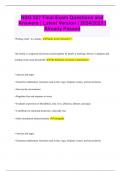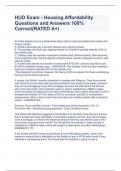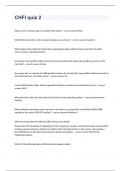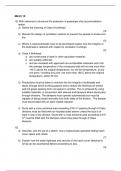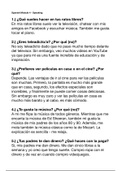GCSE EDEXCEL BIOLOGY EXAM
2024/2025 | ACCURATE AND VERIFIED
EXAM QUESTIONS AND ANSWERS FOR
GUARANTEED PASS | LATEST UPDATE
,List all the Sub-cellular structures of an Animal cell - ✔✔ANSW✔✔..1) Nucleus
2) Cytoplasm
3) Cell membrane
4) Mitochondria
5) Ribosomes
List all the sub-cellular structures of a Plant cell - ✔✔ANSW✔✔..1) Nucleus
2) Cytoplasm
3) Cell membrane
4) Mitochondria
5) Ribosomes
6) Chloroplasts
7) Vacuole
8) Cell Wall
What are the 4 different types of menstrual hormones? - ✔✔ANSW✔✔..1) FSH
(Follicle-Stimulating-Hormone) - has two roles.
2) LH
3) Oestrogen
4) Progesterone
FSH:
1) What is it?
2) Where is it secreted from?
3) When is it secreted?
3) What is its purpose? - ✔✔ANSW✔✔..- FSH (Follicle-Stimulating-hormone) is
released from the Pituitary Gland.
- It's secreted during days 1-14, and its purpose is to 'develop the egg cell & follicle' &
'break down the uterus lining'.
LH:
1) What is it?
2) Where is it secreted from?
3) When is it secreted?
3) What is its purpose? - ✔✔ANSW✔✔..- LH is a hormone that's released from the
pituitary gland.
- LH is released during day 14, and its purpose is to stimulate ovulation.
Oestrogen:
1) What is it?
2) Where is it secreted from?
3) When is it secreted?
3) What is its purpose? - ✔✔ANSW✔✔..- Oestrogen is a hormone that's released from
the Ovaries.
- LH is released during days 7-21, and its purpose is to 'restore' the uterus lining.
,Progesterone:
1) What is it?
2) Where is it secreted from?
3) When is it secreted?
3) What is its purpose? - ✔✔ANSW✔✔..- Progesterone is a hormone that's released
from the Corpus Luteum
- LH is released during days 14-28, and its purpose is to help maintain the lining of the
uterus.
1) Explain how all 4 menstrual hormones work together to maintain a smooth process.
==> For each step, discuss about its purpose, and what 'gland' it stimulates to produce.
2) Also describe the inhibitions of the necessary ones in each step.
1 + 2) 6 marker) - ✔✔ANSW✔✔..Links:
1) High levels of FSH stimulates the development of the 'egg cell and follicle'. It also
stimulates the ovaries to secrete Oestrogen.
2) High levels of Oestrogen stimulates the 're-lining of the uterus', which also stimulates
the P.G, to secrete LH.
3) High-levels of LH causes ovulation; here, the 'broken' follicle becomes the corpus
luteum, which starts producing progesterone.
4) Progesterone helps maintain the uterus-lining, but only temporarily as it runs out.
Inhibitions:
1) Oestrogen inhibits FSH (to some extent) as they both have opposite roles (one
breaks down and the other builds the uterus-lining).
2) Progesterone inhibits LH & FSH as:
2.1) Ovulation (LH) isn't necessary.
2.2) The uterus lining should be maintained, rather than being broken down by FSH.
Describe the negative feedback for low/high temperatures. (6 marker for each). -
✔✔ANSW✔✔..1) The hypothalamus (in the brain) detects a high/low temperature in our
body, and therefore causes the following effects: (1 mark)
Negative Feedback for High Body temperature (4 marks):
2.1) Vasodilation (high) ==> Here, the blood vessel muscles expand to allow greater
heat diffusion.
3.1) Here, the Erector muscles 'relax' to 'lower' the hair strands; this prevents air from
being trapped, which acts as an insulator.
4.1) Here, the Sweat glands start producing sweat, where heat diffuses through the
water.
, 5.1) Here, less shivering relaxes our muscles to decrease respiration & stop producing
heat.
Negative Feedback for low Body temperature (4 marks):
2.2) Vasocontraction (low) ==> Here, the blood vessel muscles contract to allow less
heat diffusion.
3.2) Here, the Erector muscles 'contract' to 'raise' the hair strands; this helps trap more
air around the skin, which acts as an insulator.
4.2) Here, the Sweat glands stop producing sweat to prevent heat loss.
5.2) Here, more shivering helps stimulate our muscles to increase respiration, which
produces heat.
6) As a result, the overall body temperature is brought back to normal (at 37°C). - (1
mark).
Key words: Hypothalamus, low/high temperature, vasodilation, vasocontraction, Erector
muscles (contract or relax), hair strands, air (insulator), heat, sweat glands/sweat,
shivering, respiration, 'overall body temperature' (back to normal).
1) What are Prokaryotic cells? (1 mark)
2) Provide an example (1 mark)
3) What makes then different from eukaryotic cells? (2 marks) - ✔✔ANSW✔✔..1)
Prokaryotes are Single-celled organisms.
2) E.g. Bacterial cells, such as E.coli.
3) Prokaryotes contain 'Circular DNA', instead of a 'Nucleus'. ==> (shown in diagram).
1) What are Eukaryotic cells? (1 mark)
2) Provide an example (1 mark)
3) What makes then different from Prokaryotic cells? (2 marks) - ✔✔ANSW✔✔..1)
Prokaryotes are Complex-celled organisms.
2) E.g. Plants & Animal Cells
3) Eukaryotes have 'a nucleus & a cell membrane', whereas Prokaryotes have 'circular
DNA & plasma membrane'.
Sperm cells:
1) What type of cell is it, and mention their Attributes.





